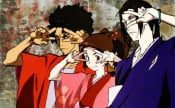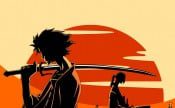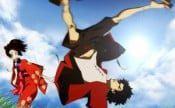Samurai Champloo Synopsis:
Mugen and Jin may both be warriors but that is where their similarities end. Mugen is an unshaved, unwashed, sarcastic opportunist who looks like a slam-dancer when he fights. Jin is a solemn, traditional samurai who fights with quick, quiet grace. These two fighters would like nothing more than to fight to the death but after a surprise rescue from execution by a flighty waitress named Fuu, the two agree to stave off killing each other long enough to return the favor by helping her find her mysterious “samurai who smells of sunflowers.” Samurai Champloo marks Shinichiro Watanabe’s first full-series directorial follow up to his 1998 hit series Cowboy Bebop. The show features the same trademark use of slick, dry humor and stylistic musical themes except this time, the music is hip-hop rather than jazz. The rap theme pulls this anime out of the traditional samurai genre, exploring a wild new take on old ideas.
Samurai Champloo Story:
A young woman named Fuu is working as a waitress in a tea shop when she is harassed by a band of samurai. She is saved by Mugen, a mysterious rogue, and Jin, a young ronin. Mugen attacks Jin after he proves to be a worthy opponent and they begin fighting one another, they inadvertently cause the death of Shibui Tomonoshina, the magistrate’s son, and are to be executed. With help from Fuu, they escape and Fuu asks them to travel with her to find “the samurai who smells of sunflowers,” a mysterious man Fuu can give little description of, but whom she insists she must find, as she thinks he’s her long lost father. They agree to join her, with Fuu setting the condition that they are not to duel one another until the journey is done.
Samurai Champloo Characters:
Samurai Champloo tells the story of three strangers in the Tokugawa era (also known as the Edo Period) who come together on a journey across Japan.
Mugen: A brash vagabond from the Ryukyu Islands, Mugen is a wanderer with a wildly unconventional fighting style. He wears metal-soledgeta and carries an exotic sword on his back. In Japanese, the word “Mugen” means “infinite” (literally, “without limit” or “limitless”).
Jin: Jin is a reserved ronin of 20 years who carries himself in the conventionally stoic manner of a samurai of the Tokugawa era. Using his waist-strung daishō, he fights in the traditional kenjutsu style of a samurai trained in a prominent, sanctioned dojo. Jin wears glasses, an available but uncommon accessory in Edo era Japan. Spectacles, called “Dutch glass merchandise” (“Oranda gyoku shinajina” in Japanese) at the time, were imported from Holland early in the Tokugawa period and became more widely available as the 17th century progressed. In Japanese, the word “Jin” means “benevolence” or “compassion.”
Fuu: A feisty 15-year-old girl, Fuu recruits Mugen and Jin to help her find a sparsely described man she calls “the samurai who smells ofsunflowers.” A flying squirrel named “Momo” (short for momonga, “flying squirrel”) accompanies her, inhabiting her kimono and frequently leaping out to her rescue.
Apart from this trio, other characters tend to appear only once or twice throughout the series.
Shamurai Champloo Images:



